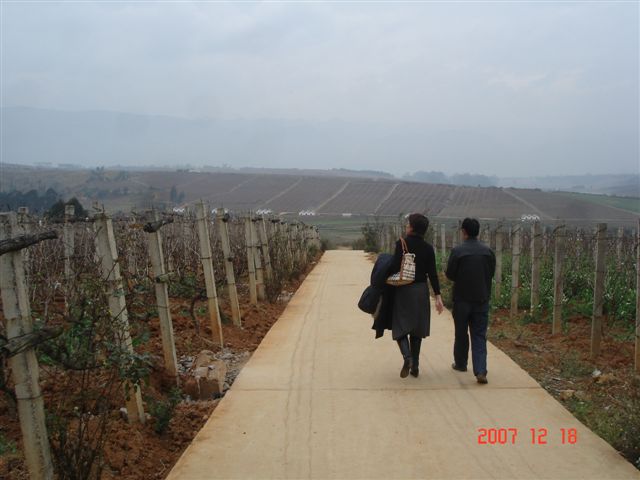By Jim Boyce
In December, I tagged along on a research trip by Ma Huiqin of China Agricultural University and visited Yunnan Red Wine Company This interview with wine maker Zhang Ning focuses on the hybrid grape French Wild and is the third in a series of posts about an area some call Shangri-La.

Checking out the grapes (J. Boyce)
Boyce: Tell us about the French Wild (France Ye) grapes you have been experimenting with and selling in small batches?Zhang (translated by Ma Huiqin): Growing French Wild is like gambling. When the fruit is 90-percent ripe, we must decide whether to harvest or to wait. If we harvest, the grapes are only good enough for entry-level wine. If we wait, let’s say up to five days, we could get rain. If it rains even overnight, the berries start splitting because they easily absorb water and they start falling from the vines. So, our strategy is to harvest some grapes early and save a portion for later harvest. This latter portion either provides good quality grapes or is wiped out.
At this point, one possibility is that the vines are young and the roots shallow, so they take on too much water when it rains. Perhaps, over time the roots will go deeper and alleviate this problem. To me as a winemaker, it also seems like the berries on the younger vines have thinner skins and this leads to easier splitting. At this point, we are not quite sure and will continue to study the situation.
A second challenge with French Wild vines is marketing. Some consumers think it is similar to our Rose Honey wine, and this makes it harder to make the grape viable. We need to explain to consumers the uniqueness of French Wild, to explain the story behind this wine.
At this point, we don’t sell an entry-level or mid-level version of French Wild, because the small amount of these grapes we grow – around 200 to 300 tons of per year – does not make it economical. So, we only make a varietal wine with the best grapes.
By the way, the background of this grape is interesting. Vines come from at least two sources. The first is from Chinese abroad who brought back clones from Southeast Asia, including Indonesia and Vietnam, in the 1950s. The vines were introduced from a Chinese refugee farm (Hua Qiao Nong Chang) which was established in the 1960s in Yunnan. We are not sure where the farm’s vines came from.
The second is from Ci Zhong Church in Yunnan’s Shangrila region. We assume these vines came from missionaries.
We have heard there are four different clones of French Wild, but we only have two types in the vineyard. Most of the information we have about these vines is anecdotal and the full story still needs to be told.
As the bottles attest, this is not a small winery. (J. Boyce)
Previous:
– Yunnan Red Wine Company CEO Wu Kegang
– Yunnan Red Wine Company GM Shan Shumin
Grape Wall has no sponsors of advertisers: if you find the content and projects like World Marselan Day worthwhile, please help cover the costs via PayPal, WeChat or Alipay.
Sign up for the free Grape Wall newsletter here. Follow Grape Wall on LinkedIn, Instagram, Facebook and Twitter. And contact Grape Wall via grapewallofchina (at) gmail.com.

Leave a Reply
You must be logged in to post a comment.